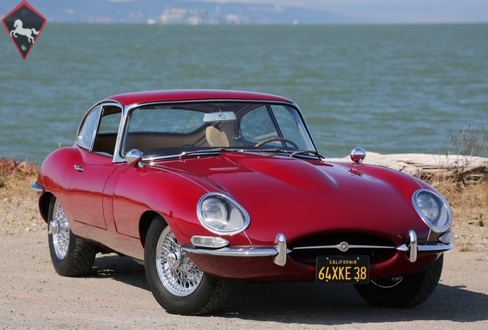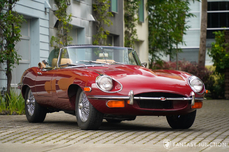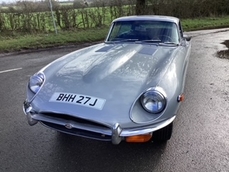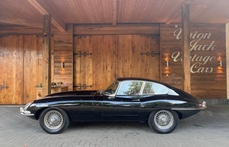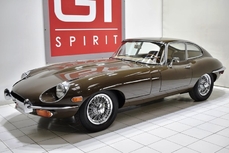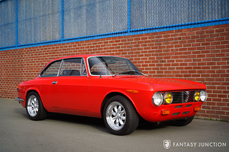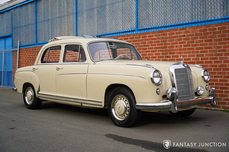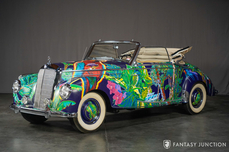Jaguar E-type 3.8 Liter Inline-6 no. RA5535-9 1964
Allgemeine Beschreibung :
1964 Jaguar E-Type Series 1 Coupe
s/n 890065, Engine block no. RA5535-9, head no. R7945-8
Dark Red with Beige Leather Interior
The E-Type was unveiled in March of 1961 at the Geneva Motor Show, following the famous 11th hour disorder (one of the cars was driven to the show from England with just hours to spare). The car was an immediate sensation: its specification was state of the art, its bodywork arrestingly gorgeous, and the price surprisingly affordable. It embodied William Lyons' values beautifully and it is no surprise that the E-Type has become so iconic. The specification clearly demonstrated Jaguar's racing experience and included independent suspension all around (at a time when Ferrari was still using live rear axles), disc brakes all around (inboard at the rear to reduce unsprung weight), and of course Jaguar's legendary twin cam inline-6. Sales were brisk and the cars were continuously developed, although later cars were less pretty and lower performing as a result of new American legislations, while the remarkable twelve cylinder engine of the Series III and accompanying changes made the E-Type less sporting.
The current owner, a Southern California resident, purchased this Series I E-Type in 2006 from the previous owner in Colorado. Over the past 12 years, the current owner has serviced the car regularly in California, purchasing and installing several parts from XKs Unlimited, installing new velour on the seat backs, and engaging Veldman’s Motoring Service Center in Rialto, CA to perform a partial engine rebuild with 09745 miles at the time of invoicing. During the engine rebuild, the original cylinder head was removed and a freshly machined head installed to the matching numbers engine block (the original head has been retained and is available). Veldman’s installed new pistons with 9:1 compression including new piston rings and rods, machined new wrist pins, installed new intake and exhaust valves, engine bearings, a new head gasket set, head bolt studs, and a bypass thermostat. While the engine work was being completed, all three carburetors were rebuilt, the timing cover was cleaned and resealed, the timing chain support bracket was replaced, and the water pump cleaned, inspected, and reinstalled. The car also received a new voltage regulator, a new auxiliary fan relay switch, oil and filter change, new hoses replaced as needed, and all fluids checked. During reassembly, careful attention was given to preparing all parts of the engine to match original Jaguar finishes. Recently, Jaguar specialist Jim Groom serviced the car including replacing fuel lines, adjusting the carburetors, fitting new spark plugs, and further tuning the car. Additional work performed in January 2019 by Vintage Auto Service included various electrical fixes to get some the horn and inoperative dashboard and exterior lights fixed, adjusting the emergency brake, changing one valve cover gasket and the oil, and various other jobs. Today, with just under 10,000 indicated miles (roughly 250 miles since the engine rebuild was completed), the car presents as a nice driver with solid cosmetics.
The overall exterior condition boasts high gloss paint with a deep finish, showing minor flaws and light scratches in various areas. There are a few areas of paint stress cracking located near the louvers, and above one taillight, but these are notable only upon close inspection. Along the rear hatch opening there is some edge chafing that has been touched up as well as a bit of touch up done near the front fender stainless bead edge, and a few other locations. While the paint finish appears nice overall, there is some evidence of color variation from the driver’s door toward the cowl. The lighting, lenses, and glass appear very clean and preserved throughout. The body integrity is solid overall, with good panel gaps on the hatch, and bonnet, while corner areas of the doors appear a bit proud of the body. The chrome window surrounds are in good original condition overall with light pitting in just a few areas. The front and rear chrome bumpers are very nice, having been recently rechromed to a very nice standard. The chrome wire wheels and desirable “eared” knock-offs are smoothly plated with no major flaws, shod with Goodyear tires.
The interior is in handsome condition, nicely complementing the exterior. The light colored interior is pleasantly taut and nicely mellowed with correct piping and tidy seams. Carpet and floor mats are in very good condition, the black dashpad is properly contoured, though showing some softening, while the very nicely finished instruments, switches, and other features of the interior all appear to be consistent and preserved. The vinyl surround for the auxiliary instruments displays some cracking. The interior door panels, matching covered doorsills, headliner, and rear hatch area are consistent in finish and texture. The seats are comfortable and firm with just enough “give” to feel cradled while engaging in more spirited driving. The interior conveys an honest and harmonious look and feel, completed by a handsome warmly hued wood steering wheel with aluminum spokes, and beautifully finished Jaguar center hub.
The engine compartment is quite nice and appears correct in appearance and detailed to nice driver standards as part of the recent engine rebuild. The various components including the properly hammertone painted air cleaner, gold cam valley, exhaust coatings, and polished aluminum castings have all been prepared with originality in mind. The correct S.U. carburetors, complete factory air cleaner assembly, and air filter box are correct and properly fit. Further components, hoses, clamps, glass windscreen washer fluid reservoir, Lockheed brake booster, and various hardware appear to have also been installed and detailed with originality in mind. The rear hatch area is correct in appearance with the proper matching interior materials consistent with the quality of the forward cabin. The trunk floor is in good condition and contains a matching spare wheel. The undercarriage appears sound, exhibiting no evidence of rust at present, although close inspection reveals some patching performed to the floor pan in the past. Inspection the rear portion of the trunk floor and license plate panel reveals evidence of prior collision damage which has been repaired. The overall integrity of the body seams and joinery is good and the suspension components appear properly prepared for driving use.
The car runs and drives well, having recently been serviced knowledgeable experts. Carburetor and valve adjustments have been performed, the fuel system inspected, and fuel lines replaced as needed. The engine makes good power and torque, pulling nicely in all gears. When pulling away from a stop after extended idling, some smoke can be observed, and professional inspection suggested that the rings have not seated since the rebuild. The gearbox works well, with good shifting in all gears, although first gear is somewhat noisy, which is not atypical for these Moss gearboxes with unsynchronized first gear. Once at speed, the car exhibits a stable ride, with good steering, very much in keeping with the overall condition of the car. The brake display some pulsation when applied at low speeds. The car comes with a vintage Hartmann suitcase, and the original cylinder head is available as well.
This is an excellent opportunity to acquire a nice driver quality attractively priced Series 1 E-Type Coupe with original matching numbers engine block, clean presentation, and comfortable interior. The beautiful and legendary E-type design coupled with recent mechanical work offers the new owner an immediately rewarding example, ready to drive and enjoy for years to come.
http://fantasyjunction.com/cars/2146-Jaguar-E-Type%20Coupe%20Series%20I-3.8%20Liter%20Inline-6
1964 Jaguar E-type 3.8 Liter Inline-6 no. RA5535-9 is listed verkauft on ClassicDigest in Emeryville by Fantasy Junction for $89500.
Fakten der Auto
Karosserietyp : Auto Marke : Jaguar Modell : E-type Ausführung : 3.8 Liter Inline-6 no. RA5535-9 Hubraum : 3.8 Modelljahr : 1964 Lage : Emeryville
Verkauft
Angaben Zum Verkäufer
Verkauft
People who viewed this Jaguar E-type also viewed similar Jaguar listed at ClassicDigest
Other cars listed for sale by this dealer
über Jaguar
Ah, die Geschichte von Jaguar, von seinen Anfängen als SS Cars Ltd. bis hin zum Höhepunkt mit dem D-Typ und der Straßenversion des ikonischen E-Typs. An dieser Erzählung haftet etwas zutiefst Britisches, und ich werde sie erzählen, wie es ein britischer Journalist tun würde.Die Anfänge:
Unsere Reise in die Welt von Jaguar beginnt in den 1930er Jahren, als ein Unternehmen namens SS Cars Ltd. auftauchte. Trotz des unglücklichen Zufalls ihrer Initialen, die mit den aufkommenden politischen Spannungen in Europa zusammenfielen, begannen sie, stilvolle und leistungsorientierte Autos herzustellen. Der SS 100, der 1936 eingeführt wurde, war ein Symbol für Eleganz und Geschwindigkeit und legte den Grundstein für das, was Jaguar werden sollte.
Die Geburt von Jaguar:
Als der Schatten des Zweiten Weltkriegs näher rückte, entschied sich SS Cars Ltd. klugerweise, sich von den SS-Initialen zu distanzieren. So wurden sie 1945 offiziell zu Jaguar Cars Ltd., ein Name, der bald für britischen Luxus und Leistung stehen würde.
Die XK-Serie:
Die Nachkriegszeit von Jaguar brachte uns den XK 120, eine wahre Sensation im Jahr 1948. Mit seinem schlanken Design und einem leistungsstarken 3,4-Liter-Sechszylindermotor wurde er zum schnellsten Serienauto der Welt. Der XK 120 war die Blaupause für das, was kommen würde - Jaguars, die Stil mit Geschwindigkeit auf einzigartig britische Weise verbanden.
Die Dominanz des D-Typs:
Dann kam der D-Typ, eine wahre Rennlegende. 1954 eingeführt, gewann er in den 1950er Jahren dreimal Le Mans und zeigte die technische Kompetenz von Jaguar. Mit seiner innovativen Monocoque-Konstruktion und der ikonischen Finne hinten war der D-Typ der Höhepunkt von Jaguars Motorsporterfolgen.
Das Auftauchen des E-Typs:
Aber der wahre Wendepunkt kam 1961 mit der Einführung des E-Typs, oft von Enzo Ferrari als "das schönste Auto, das je gebaut wurde" bezeichnet. Seine lange Motorhaube, die geschwungene Karosserie und ein 3,8-Liter-Motor, der atemberaubende Leistung lieferte, machten ihn sofort zu einem Klassiker. Der E-Typ war nicht nur ein Auto; er war ein Kunstwerk auf Rädern und konnte auf der Straße 150 Meilen pro Stunde erreichen.
Straßen- und Rennsporterfolge:
Die Schönheit des E-Typs wurde durch seine Leistung auf der Rennstrecke unterstrichen. Die leichten E-Typen waren bei verschiedenen Rennveranstaltungen besonders erfolgreich und festigten den Ruf von Jaguar als eine Kraft, mit der man im Motorsport rechnen musste.
Das Zeitalter der Raffinesse:
Je tiefer wir in die Geschichte von Jaguar eintauchen, desto mehr erkennen wir, dass die 1950er und 1960er Jahre ein Zeitalter der Raffinesse und Expansion waren. Neben dem großartigen D-Typ und dem ikonischen Aufstieg des E-Typs führte Jaguar Modelle ein, die seinen Ruf für Luxus und Leistung weiter festigten.
Der MK2:
Ende der 1950er Jahre stellte Jaguar den MK2 vor, eine Sportlimousine, die Eleganz mit Leistung vereinte. Diese elegante viertürige Limousine war sowohl bei Bankräubern als auch bei der Polizei aufgrund ihrer außergewöhnlichen Geschwindigkeit und Handhabung beliebt. Der MK2 war ein Symbol für Jaguars Fähigkeit, Raffinesse mit Leistung zu verbinden und hatte auch eine erfolgreiche Rennkarriere.
Der XJ6:
Springen wir ins Jahr 1968, als Jaguar ein Auto auf den Markt brachte, das Jahrzehnte lang Luxuslimousinen definieren würde - den XJ6. Es war ein Meisterwerk der Ingenieurkunst und des Designs, mit einem sanften Reihensechszylindermotor, unabhängiger Hinterachse und einem geräumigen, wunderschön ausgestatteten Innenraum. Der XJ6 war ein Symbol britischer Eleganz und bot eine so sanfte Fahrt, dass es schien, als würde er förmlich über die Straße gleiten. Er wurde zum Flaggschiffmodell für Jaguar und setzte den Maßstab für Luxuslimousinen und zeigte ein Maß an Raffinesse, das die Konkurrenz staunen ließ.
Die Verschmelzung von Klassik und Moderne:
Während der MK2 und der XJ6 die Evolution der Limousinen von Jaguar repräsentierten, bewahrten sie das Engagement der Marke für Leistung und Luxus. Diese Autos gehörten nicht nur auf die Rennstrecke; sie fühlten sich genauso wohl auf den Prachtstraßen wie auf einer entspannten Fahrt durch die englische Landschaft.
Die Herausforderungen des Wandels:
Dennoch sah sich Jaguar mit dem Eintritt der 1970er Jahre, wie viele britische Automobilhersteller, finanziellen Herausforderungen und Veränderungen in der Eigentümerschaft gegenüber. Die Ära von British Leyland brachte sowohl Chancen als auch Schwierigkeiten mit sich, während die Marke durch verschiedene Fusionen und Übergänge navigierte.
Das Erbe des MK2 und des XJ6, zusammen mit dem D-Typ und dem E-Typ, definiert Jaguar weiterhin als einen Hersteller, der zeitlose Eleganz mit einer Leistungsstärke vereint. Diese klassischen Modelle, ob sie über kurvige Straßen gefahren oder als Sammlerschätze geparkt werden, dienen als Zeugnis für die anhaltende Präsenz von Jaguar in der Welt der automobilen Exzellenz.
Die Jaguar-Geschichte, von ihren Anfängen als SS Cars Ltd. bis zur Schaffung von Automobilikonen wie dem E-Typ, dem MK2 und dem XJ6, ist eine Reise, die das Wesen des britischen Automobilbaus widerspiegelt - eine Mischung aus Luxus, Leistung und Stil, die nach wie vor Enthusiasten und Kenner gleichermaßen fasziniert.
